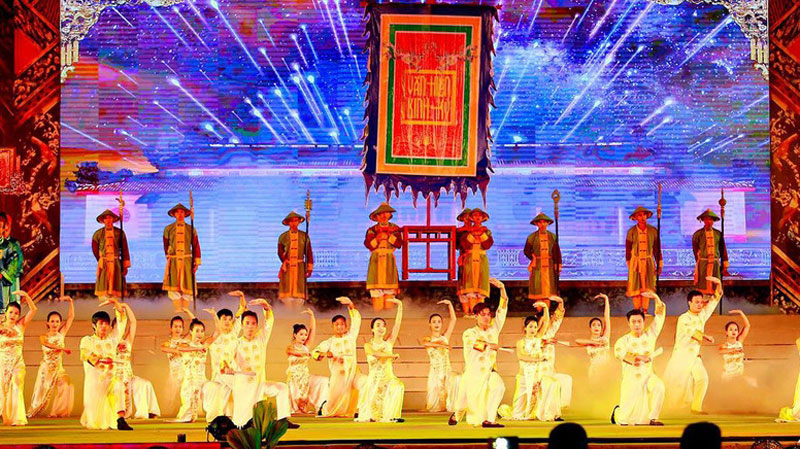
Nearly 1,300 domestic and foreign artists are brought together at the 2018 Hue Festival, which is taking place from April 27 to May 2 to stage unique art performances representing the typical cultures of different regions in Vietnam and abroad.

A performance at the Hue Festival
A music show featuring "hat xam”, "hat cheo”, "nha nhac” (Hue royal court music) was held at Dien Tho Palace in the imperial city of Hue on April 30, attracting a large crowd of people who love traditional melodies.
Considered a highlight of the Hue Festival 2018, "Van Hien Kinh Ky” (Capital Civility) was a comprehensive art show which combines a variety of elements: dance, chorus, animation, poem reciting and music. The 90-minute show featured all cultural values of Hue through heritage elements.
The same day, a cartoon exhibition of the French Nouvelle Aquitaine region displayed popular works by French artists, presenting various stories in three languages: French, English and Vietnamese.
Earlier on April 29, a programme titled "Am Vong Song Huong” (Resonance of Perfume River) involved hundreds of professional and amateur actors and actresses, depicting the life cycle of people living on the rivers from their marriage, giving birth and raising children to passing down their occupation from generation to generation in a joint effort to preserve Hue cultural values.
A street festival is being held on main routes of Hue from April 28 to May 1 with the engagement of art troupes from Thailand, Japan, Poland, Mongolia, Slovakia, Belgium and Vietnam.
Within the framework of the festival, visitors were treated to art performances staged by the beatbox/acapella Berywam from France, Urpin folk artists from Slovakia, Yaese lion dance troupe from Japan, singer Noa from Israel, Nematatlin musical band from Mexico and Pambil band from Colombia, among others.
Source: NDO
Hoa Binh province has carried out multiple programmes and initiatives to revive its cultural heritage which has gradually fallen into oblivion through the ebbs and flows of history.
The most prominent and defining feature in the prehistoric era of Hoa Binh is the Hoa Binh Culture. The Culture was first discovered in Hoa Binh. The significant prehistoric culture represents not only Vietnam but also Southeast Asia and southern China. Through excavations of cave sites in the limestone regions of Hoa Binh, French archaeologist M. Colani introduced the world to a "Stone Age in Hoa Binh province – Northern Vietnam" in 1927. On January 30, 1932, the First Congress of Far Eastern Prehistorians, held in Hanoi, officially recognised the Hoa Binh Culture.
Known as the "Land of Epic History”, Hoa Binh province, the gateway to Vietnam’s northwest, boasts a strategic location and a unique cultural tapestry woven by its ethnic minority communities.
The People's Committee of Luong Son District recently held a ceremony to receive the certificate recognizing Sau Communal House in Thanh Cao Commune as a provincial-level historical and cultural site.
Recognising the importance of cultural heritage preservation in protecting and promoting the value system of Vietnamese culture, and serving socio-economic development in the new period, Party committees and local administrations in Hoa Binh province have identified it as a key task in the cultural development strategy. The province has been making efforts in mobilising resources, creating consensus among people and engaging ethnic communities in preserving and promoting cultural identity.
Hoa Binh province has captured growing attention both domestically and internationally for its distinctive cultural heritage and rich history. Most notably, it has been renowned for its famous Hoa Binh culture, considered the cradle of ancient Vietnamese civilisation. Looking ahead to significant milestones in 2025 and the 140th anniversary of province establishment in 2026, Hoa Binh Newspaper presents a comprehensive overview of the province's development across economic, social, cultural, tourism, and security domains.



